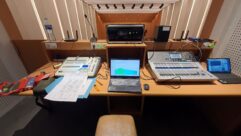Bad sound from good intentionsHow can someone adequately do the work of a soundperson without knowing the fundamentals of audio?
Jan 20, 1997 12:00 PM,
By Drew DanielsDaniels is owner of Sound Path Ltd./Sound Path Labs, a design and consulting firm in
I have some bad news. Although it may be true that you’ve mixed at the House of Blues, B.B. King’s, the Roxy, the Whiskey, the Derby, the Viper Room and all the others, I’m sorry to tell you that you’re not qualified to do live sound mixing here at the Ash Grove. You see, your answers to our employment quiz clearly suggest that you shouldn’t be allowed to touch an audio system.”
It seems incredible that people who already have backgrounds like these wouldn’t be ideal candidates for mixers in a simple 300-seat dinner theater like the Ash Grove. It’s only been open eight weeks as of this writing, but in that time I’ve been easily able to get consistently good sound, sound that elicits comments about great sound both from the audience and performers. In fact, my reputation has spread to the East Coast and acts from New York routinely call to ask if I’ll be their sound person on the night of their performance. At the same time, I’ve heard consistently bad sound from most mixer substitutes. At the very best, the sound isn’t all that the system will allow it to be.
Opening night at the Ash Grove saw me still mounting amplifiers into the rack and sounding wires right up to show time – no EQ adjustments, no crossover balancing except by ear and no level calibrations except by ear. Robert Hilburn, music critic of the L.A. Times (who usually trashes every sound installation) wrote, “The Ash Grove is blessed with superb sound” after the evening’s concert, which included R&B rockers Don & Dewey and the entirely a capella singing group, the Persuasions. Both groups offered signal material capable of revealing sound-system inadequacies.
Now I refuse to believe that I’m that much smarter than other engineers. But wait. There’s a catch; these guys are not engineers. The vast majority of “soundpeople” have little or no engineering education at all.
A torrent of amateurs, a dearth of expertsThe number of résumés that cross your desk as soon as you open a new venue is astounding. That, in itself, is part of the problem: The job market is oversaturated with wannabe sound-people. Literally thousands of knob-twisters want to be close to the glamour of show business. They stand at the console and constantly adjust the faders and knobs as if the tiny movements must continue or the patient will die. Actually, the constant adjustment stems directly from feelings of inadequacy and fear that the club owner will see a lack of activityas reason for assuming that thetask is less than horribly complex. Or maybe, when you’re working forthe standard $10 per hour, you know you’re not taken seriously unless you adjust constantly.
Out of dozens of résumés and interviews I’ve been through, 99% of applicants don’t know what a pan pot does. Yes, they know it pans from left to right, but they don’t know how it works or that it’s supposed to produce equal volume from the loudspeakers as you pan from one side to the other by using a resistance taper that smoothly reduces each of the channels to half-power (-3 dB) at the 12 o’clock position. They can’t tell me what balanced lines are, what a cardioid microphone is, what the inverse-square law is or what a decibel is. They don’t even know how many decibels it takes to make something sound twice as loud, or if they do, how many decibels it takes to make it half as loud.
In fact, most of these guys think that dBs are voltages rather than differences, and even at that, they can’t tell me the difference between +4 and -10 or how to calculate them.
I’ve tried and failed even to imagine how it might be possible to adequately do the work of a soundperson without these fundamentals imprinted on your brain like your name.
A part of the problem is that many of these guys started out by simply watching a mixer at work to absorb what they could about mixing, and then one day they just announced that they were mixers and got hired. It’s not hard to get hired because the ignorance of those who pay the bills is far greater than that of the potential soundperson. If the soundperson gets lucky, he may be able to make better sound than the person he replaced and keep the job. Luck, however, doesn’t make him an engineer, and without engineering skills, he’ll eventually run up against problems that are sure to expose his lack of engineering training.
A couple of amusing anecdotes: a record company brought a new band from Canada for a record release tour. They would play a short set in addition to the scheduled show that night. The record company thought the Ash Grove date important enough to bring in a hot-shot live sound mixer to make sure the group sounded as good as possible. The soundperson, a really nice guy, barged into my sound booth and demanded to mix (he wanted to earn the money they were paying him), then proceeded to assign every mike to every bus, pan every channel to the center, and boost the bass until it sounded like a rap group on ganja – this for a group with an accordion and a mandolin! The sound level was twice as loud as it should have been. Patrons were covering their ears or holding their noses on the way out, and we lost our audience for the two shows scheduled for the evening.
On one of my nights off, a wonderful blues artist played the Ash Grove, and his soundperson called me, at home, in a panic, to ask how the console EQ was configured. I told him that the EQs were all pre-fader and pre-monitor and that I had calibrated the sound system so every loudspeaker and every monitor was as flat as possible because I had no separate EQ units for monitors – only the house EQ parametrics I installed to use with the JBL Smaart dual-channel FFT program. He grumbled about how it was all wrong and impossible to work that way, then he hung up. A few minutes later, a call from the assistant working that night asked whether the soundperson could use the house EQs to do his monitor EQing. I answered, “Absolutely not! And whatever you do, don’t let him upstairs” (to the amp/crossover rack). The next day, my business partner called me and asked, “Are you involved with the Ash Grove?” Why? I asked. “Two of my employees went down there last night and told me the sound was the worst they ever heard, that the sound system sucks and that it must have been over 120 dB in there; they had to leave.” The next day, when I arrived at the Ash Grove, I found all the house EQs altered so radically that all of the loudspeakers sounded like a K-Mart boom box and all of the levels were 10 dB to 15 dB out of whack so the console hiss could be heard throughout the system.
I charge $200 an hour to calibrate sound systems. I’m good at it. When I leave, any competent audio engineer can use the system and know exactly what it will do. As I write this, I’m preparing a second $400 bill for re-calibrating the system at the Ash Grove because of yet another soundperson who knows better than the designer how the system should be configured and used. (The designer who got those good reviews I mentioned, remember?)
My gripeFirst, it’s really disrespectful and shows bad upbringing to denigrate someone’s design, let alone rework it without permission and leave it for others to discover and try to sort out five minutes before show time. The insult is that much greater when the system has already proved itself and has consistently performed at unprecedented quality.
Second, no one should ever presume to know better than the designer of a venue’s sound system (even if it does suck) on a one-nighter. Get a life.
And lastly, it absolutely shows the incompetence of the operator if he can’t step into a proven successful installation and do good work with it. The latter being the case, he should defer to those who operate the system successfully, since the goal is always the same: to produce good results and convey artistic intention to the audience.
Soundpeople reading this, take note:
*The audience pays the bills.*The audience is paying for the artist.*The audience is not paying for you.*You are not the artist; you are not on stage.*The audience shouldn’t even know you’re there. (If you’re successful, you’ll be totally transparent to the performance.)*If that’s not glamorous enough for you, get out of the business.Venue owners reading this, take note:*Dr. Decibel’s first rule of economics: false economy is the most expensive kind.*Don’t hire $10 sound hacks. If you all stop this practice, the supply will dry up.*If you run a show room, ask yourself if your product is actually good sound or just beer.*Half of every sound system is the room it’s in. Spend some of your audio budget on room treatment, and your sound system will actually cost less. It will most certainly work better.*Don’t give in to gadgetitis. Keep your system simple. Don’t buy any extra outboard gear you don’t actually need to make good sound. You’re unlikely to find sound people who know enough to make beneficial use of it anyway.
If that’s not glamorous enough for you, get out of the business.
Of haves and have-notsLet’s face facts. We are not all created equal. Not everyone can understand Ohm’s law or make change or calculate the tip for dinner. Not everyone is cut out to be an engineer just because of desire. I myself am no math wizard, but I have a calculator and all the books I need, and I’ve beaten the necessary stuff into my head by incessant study because I have to.It’s no crime not to know the law of inverse-squares, but let me be blunt: If you haven’t done your homework when you get into a race car, you’ll probably die. If you haven’t done your homework before you step into a complex audio system, artistic intention will suffer.In my egomaniac opinion, people who just get by with audio shouldn’t be allowed to continue. If bad sound were lethal, we’d all be dead; but the ubiquitousness of bad sound is no justification for it. I know of several large sound-system owner-operators who have wildly variable degrees of success and failure with their systems and somehow go on managing to serve their clients while disserving the artists for whom they provide sound. One of these fellows worked for an artist when the artist played the Universal Amphitheater in Hollywood. My wife and I walked out of the show after suffering through it for 45 minutes while the soundperson tried to figure out why the house was only being fed a vocal and a kick drum while the rest of the band and backup singers might as well have stayed home. I’m not saying I could have done better, but I am most certainly saying that the show would have been a show if they had let the house mixer do what he had done for another group a couple weeks earlier, where the sound rivaled that of the album master playback in the studio’s control room.
Necessary complexityWhy do “soundpeople” find it difficult to work the Ash Grove? Quite simple: they’re not used to doing things the way the system was designed to work.The first issue is the three loudspeaker stereo mains system over the stage. The stage is a corner-stage looking into a room space approximately 55 feet by 70 feet (16 m — 21 m) with a 20 foot (6 m) rafter height with an absorbent ceiling above that – fairly close to square. I decided to use stereo because I could, on the simple theory that it sounds more interesting than monaural and would give the Ash Grove an advantage over venues that could not offer it.
The narrow placement of the three loudspeaker mains, within eight feet of each other near a corner, allows me to put 120° horns in each loudspeaker and cover the entire room from all three point sources, all near the action on stage. Few live sound mixers are used to mixing in stereo. They’re afraid of it, and because most mixers have never heard stereo, when they do, they think it’s broken.
It’s unusual for the loudspeakers to be close together near a stage. It’s much more common to see loudspeakers mounted to the sides of a stage where they can provide the familiar disembodied sound – you know, like a “sound system” – rather than providing sound anything like artists and instruments on the stage below. I have only myself to blame for wanting to help convey artistic intention instead of creating a sound system that’s the star of the venue, rather than the artists on stage.
The second issue is the center loudspeaker itself. As any sound-system designer should know, sound from one loudspeaker is always clearer than sound from two because no interfering waves are coming from multiple sources. This is particularly true at the Ash Grove because I have installed more than 6,000 sabins of absorption in a 4,000 ft2 (372 m2) room, designed room features to assure reverberation diffusion and installed absorbent trapping under all the overhead surfaces. The place is “dead as a stump,” and the acoustics couldn’t be better, even without a sound system. There are few echoes, and those that exist are all low-level returns. I use the center loudspeaker for clarity of voices for solo artists and sometimes for instruments such as a kick drum or upright bass. This creates confusion for most mixers because they’ve never mixed for film or Dolby surround television.When I say I decided to use stereo because I could, what I mean is that in ideal situations like the Ash Grove it’s possible to place acoustic images of artists and instruments above the artists and instruments so that the audience hears the image at the same angle at which they view the source of the image on stage. This makes the performance much more realistic in terms of eliminating the impression of the sound system as the star of the show and allows the audience’s attention to be focused on the performer instead of the loudspeakers, which in my mind is an absolutely essential characteristic of a successful sound-system design.
Where stereo is a no-noI recently returned from the Strawberry Music Festival in Yosemite National Park. This three-day music concert and camping with fireside jam-sessions features a rather typical, large rock-concert-style stage outfitted with a big monitor mixer in the wings and a front-of-house station built 300 feet (91 m) in front-center, all out on a flat meadow. The stage is about 60 feet (18 m) side to side, and the loudspeaker clusters are set out farther to the sides, perhaps 100 feet apart. They are under-built clusters for the venue, and they tend to throw sound in roughly 75° lobes straight out with relatively little energy getting out to the extreme sides, especially across the middle seating area – probably intentionally. However, the performances are broadcast in stereo on a tiny FM station called “Hog Ranch Radio” set up so all the folks in the camp (about a mile radius) can listen whether they’re jamming at their campsites or in the music meadow. Cutting to the chase, we sat down front and off to the right for a performance of the Laurel Canyon Ramblers, a six-man bluegrass group, and were dismayed to find that the only fiddle solo or banjo solo we could hear was mike-monitor leakage into the stage-left mains feed. It sounded as though the soloists’ mikes were off and we were only listening to leakage. The soundman explained later that his priority was the radio feed, and it so happened that he had no way to get a stereo feed to the radio and a panned or center feed to the house on his Yamaha PM3000 console – an excuse I doubt very much.
I’ve been mixing since the days when individuals used to haul their personal Altec A-7s to a concert with a McIntosh 75 W tube amp and a Bogen mixer, on and off, not as a profession. I’m mainly a sound-system and component designer and a performer. Since 1960, roughly when I started getting involved with sound on a professional basis, I’ve heard mostly bad sound. Admittedly, it’s a stretch to be objective about sound because some of the performances color one’s memory of how good or bad the sound was, but I venture to say that in more than 31/2 decades of listening to concerts, clubs, theaters and the like, the sound was either bad or inadequate 90% of the time. The reasons are easy to discern – the three basic things that work against good sound, which are:Audio is a field where limited or partial success is tolerated. So-so sound is, after all, better than none at all.Because partial success is tolerated, thousands of ill-prepared and inferior talents rush to make a buck in a field where they think an enormous investment in study and personal discipline is not required.The science needed to produce excellent sound is way beyond “sound-people” and most audio engineers, who are not really engineers. It is so complex as to produce unsolvable problems for all but the most knowledgeable acousticians and audio designers. If this were not true there would probably be hundreds of big touring sound companies instead of a handful.
In this brief missive, I hope I’ve offended all the incompetent sound-people out there and comforted all the competent, as well as informing readers of how lousy your chances of finding a competent mixer are. I have no solutions for this, but I’ve toyed with the idea of conducting some really expensive classes.
More bad newsAs I finish off these thoughts, the Ash Grove itself, where I am mixing the important shows on weekends, is in the false economy mode insofar as sound is concerned. I am now too important – read that “too expensive” – to be wasting my time mixing sound there, except of course, when the artists insist I do or when an album is being recorded. Lee Ritenour is blocking three days to do a CD at the Ash Grove at the end of January because VanDyke Parks did one in September and boosted the Ash Grove as key to its success. I’ll receive album credit on Parks’ project and was offered the position of chief of engineering by one of the two major record companies who participated that evening.
The Ash Grove’s decided that the prevailing rate of $10 an hour for soundpeople is all they should have to pay. You see, even with the consultation of an expert and the raves about the sound, they still don’t get it. There hasn’t been so much as one word of advertising about the sound at the Ash Grove – probably because management thinks no one would care (the same way they don’t care when deliberately choosing a THX movie theater in which to see the newest Spielberg blockbuster). Ah, if only sound were visible!










